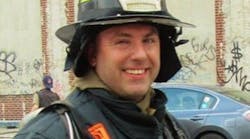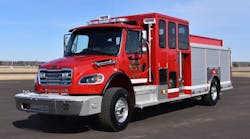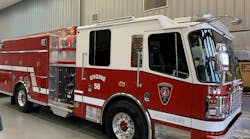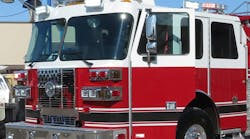The Carlisle Fire Department in Cumberland County, PA, operates from three volunteer staffed stations with career personnel utilized as drivers for their apparatus fleet. The Empire Friendship Firefighters Association was formed a number of years ago as a result of two separate fire companies consolidating under one roof. Company 45, located on the north side of the Borough of Carlisle, operates a 2008 Sutphen pumper as Engine 45 together with a 1998 Emergency One 95-foot rear-mount aerial tower as Truck 45. Other units include a 1992 mini-pumper and a 2006 air wagon, both built by Emergency One. In addition a 1987 Sutphen pumper serves as a department reserve engine.
The pride of the fleet is Engine 45 which was designed by company members, including the career staff, working closely with the sales engineering group from Sutphen. The apparatus is based upon a Sutphen Monarch cab and chassis with a 215-inch wheelbase. The unit is powered by a Detroit Diesel Series 60 engine rated at 455 horsepower through an Allison EVS-4000 transmission. The chassis' gross vehicle weight rating is 53.000 pounds using a 22,000 pound rated front axle and 31,000 pound rated rear axle. The raised roof cab provides seating for six personnel with forcible entry tools safely secured on the rear wall with 9G rated brackets.
The firefighting capability of this apparatus is provided by a Hale Q-Max single-stage pump rated at 2,000 gpm which is enhanced by a Hale CAFS system which can supply any of the 10 preconnected attack lines on the unit. The pump panel of both sides of the apparatus is fully enclosed behind roll up shutter doors which protect the panel instruments and provides ready access to four preconnected two-inch attack lines that are loaded in pull-out trays.
Hose Loads Feature Easy Deployment
A unique feature here is that the discharge for each of the attack lines is located immediately below each hose tray, making it very easy to advance the line to another location in conjunction with a 300-foot preconnected three-inch leader line off the rear hose bed. The crosslay beds are positioned low ahead of the pump panel providing easy deployment of these lines from both sides of the apparatus. Each of the hoselines are color coded both on the pump panel gauge and the controlling gate, as well as the hoseline itself to minimize confusion on the fireground. The initial attack capability of this unit is provide by a 1,000-gallon water tank.
The first-due response area for Engine 45 encompasses both urban and rural water supply areas. For this reason the unit carries two 150-foot three-inch lines for tanker refilling as well as a compliment of hard sleeve, low level strainers and water transfer appliances. All three of the pump suctions are equipped with master intake valves which are controlled at the pump panel with manual overrides. Two on-board foam cells provide 20 gallons of Class A concentrate and 100 gallons of Class B foam for use with an array of hand-held foam nozzles as well as a foam nozzle that can be deployed on the Task Force remote controlled master stream appliance mounted above the fire pump. On each side of the pump panel is a gated inlet which provides the capability to supply the Class B foam system directly from another source once the on-board foam cell is depleted.
In addition to the variety of attack lines ranging in length from a 100-foot forestry trash line to several 300-foot two-inch attack lines. The hose bed carries 1,500 feet of five-inch supply line and a 300-foot preconnected line equipped with a Task Force Blitz Fire gun. Tailboard guns, or step guns as they are called locally, provide the ability to rapidly place into service a 500-gpm master stream device in any location without having to commit personnel or apparatus into a hazardous location. Given the variety of preconnected attack lines and the master stream capability of Engine 45, this apparatus provides a great degree of tactical flexibility on the fireground for the incident commander without having to utilize multiple engine companies to gain this fire flow capacity.
Well-Designed Compartment Configuration
Beyond the fire pump and hoseline capabilities what makes this engine company stand out from others is the compliment of tools and equipment that are carried and well arranged within the aluminum body compartments. The equipment within each of the seven body compartments were laid out and designed by company members with several of the career staff who were handy with woodworking tools. The rear walls were lined with hardwood, stained and then each piece of equipment was individually mounted and labeled. When you look inside any compartment is becomes readily apparent if any tool or appliance is missing at the end of an incident. Using a combination of brackets that are commercially available and several that were custom made, from extinguishers, hand tools, electrical adapters and shovels are mounted in place with a purpose as to function and location on the unit. By employing roll-up doors on the pump panel and hinged doors on the apparatus body the fire company was able to maximize the enclosed compartment space within the body without having to sacrifice space lost to other body components.
Several safety related items include the use of an aluminum tread plate hosebed cover to protect this area together with a power operated ladder rack, which allows both high side compartments on the right side of the body and when lowered provides ready access to the portable ladders. Both 12-volt and 120-volt scene lights are provided on both sides of the body and at the rear in place of the standard utility lights. Most importantly, access to the rear hosebed is with fixed steps featuring a wide foot pattern including a full width intermediate step below the main supply line bed which provides protection for the back up camera and traffic arrow stick.
From bumper to back step Engine 45 is an excellent example of a well thought out and developed engine company. Whether your department serves a built-up urban area or a rural area without benefit of hydrant protection there are several thoughts and ideas that you can borrow from this unit to enhance the capabilities of your departments engine company apparatus.
I would like to acknowledge the assistance of Chief Matthew Boyce of the Empire Friendship Fire Company and Driver/Operator Bob Snyder for their kind help with this article.
TOM SHAND is a 37-year veteran of the fire service having served with departments in Maryland, Pennsylvania and New York. He has worked in the fire apparatus industry since 1985, including 15 years with Saulsbury Fire Apparatus. He is a contributing editor to Fire Apparatus Journal and Firehouse Magazine and works with Mike Wilbur at Emergency Vehicle Response. He co-hosts the Apparatus Architects podcast with Wilbur, based on their column in Firehouse Magazine.









